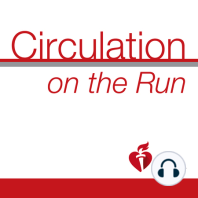17 min listen
Circulation December 6, 2016 Issue
ratings:
Length:
24 minutes
Released:
Dec 5, 2016
Format:
Podcast episode
Description
Dr. Carolyn Lam: Welcome to Circulation on the Run, your weekly podcast summary and backstage pass to the journal and its editors. I'm Dr. Carolyn Lam, associate editor from the National Heart Center and Duke National University of Singapore. Our feature discussion is regarding the exciting results of the masked hypertension study showing that clinical blood pressure underestimates ambulatory blood pressure, but first here's your summary of this week's issue. The first study reviews the largest clinical experience so far with pulmonary vein stenosis following ablation for atrial fibrillation. First author Dr. Fender, corresponding author Dr. Packer and colleagues from Mayo Clinic Rochester, Minnesota evaluated the presentation of 124 patients with severe pulmonary stenosis between 2000 and 2014 and examined the risk for re-stenosis after intervention utilizing either balloon angioplasty alone or balloon angioplasty with stenting. All 124 patients were identified as having severe pulmonary vein stenosis by CT in 219 veins. 82% were symptomatic at diagnosis with the most common symptoms being dyspnea, cough, fatigue and decreased exercise tolerance. 92 veins were treated with balloon angioplasty, 86 with stenting and 41 veins were not intervened on. The acute procedural success rate was 94% and did not differ by initial management. Overall, 42% of veins developed re-stenosis, including 27% of veins treated with stenting and 57% of veins treated with balloon angioplasty. The three-year overall rate of re-stenosis was 37% with 49% of balloon angioplasty treated veins compared to 25% of stented veins developing re-stenosis. This was a difference that remained significant even after adjusting for age, CHADS2 VASC score, hypertension and time period of the study with an adjusted [inaudible 00:02:30] ratio of 2.46 for risk of re-stenosis with balloon angioplasty versus stenting. In summary, this study shows that the risk for pulmonary vein re-stenosis is significant following atrial fibrillation ablation. The diagnosis is challenging due to non-specific symptoms and while there is no difference in acute success by type of initial intervention, stenting significantly reduces the risk of subsequent pulmonary vein re-stenosis compared to balloon angioplasty. The next paper shows that the index of microvascular resistance, which is a novel invasive mreasure of coronary microvascular function, has emerging clinical utility as a test for the efficacy of myocardial re-perfusion in invasively managed patients with acute ST elevation myocardial infarction. In this study by first author Dr. [Carrick 00:03:30], corresponding author Dr. Barry and colleagues from the University of Glasgow in Scotland, index of microvascular resistance and coronary flow reserve were measured in the culprit artery at the end of percutaneous coronary intervention in 283 patients with ST elevation myocardial infarction. Authors found that compared with standard clinical measures of the efficacy of myocardial re-perfusion, such as ischemic time, ST segment elevation and angiographic blush grade, the index of microvascular resistance was more consistently and strongly associated with myocardial hemorrhage, microvascular obstruction, changes in left ventricular ejection fraction and left ventricular end diastolic volume at six months as well as all caused death of heart failure during the median follow up of 845 days. In fact, compared with an index of microvascular resistance greater than 40, the combination of this index and coronary flow reserve less than two did not have incremental prognostic value. The take-home message is therefore that an index of microvascular resistance above 40 represents a prognostically validated reference test for failed myocardial re-perfusion at the end of primary percutaneous coronary intervention. This study supports further research into microvascular resistance based therapeutic strategies in these patients. The ne
Released:
Dec 5, 2016
Format:
Podcast episode
Titles in the series (100)
Circulation January 24, 2017 Issue: Circulation Weekly: Your Weekly Summary & Backstage Pass To The Journal by Circulation on the Run
